Engage NY Eureka Math 1st Grade Module 2 Lesson 21 Answer Key
Eureka Math Grade 1 Module 2 Lesson 21 Sprint Answer Key
A
*Write the missing number.
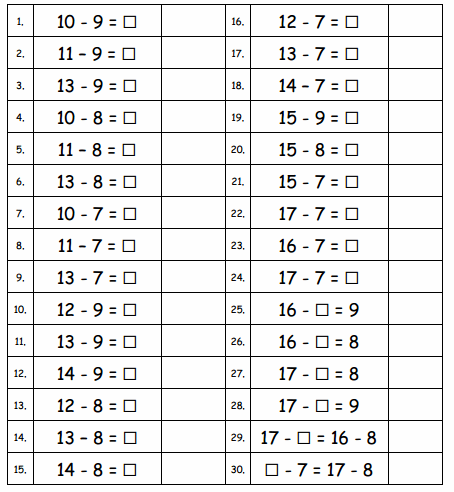
Answer:
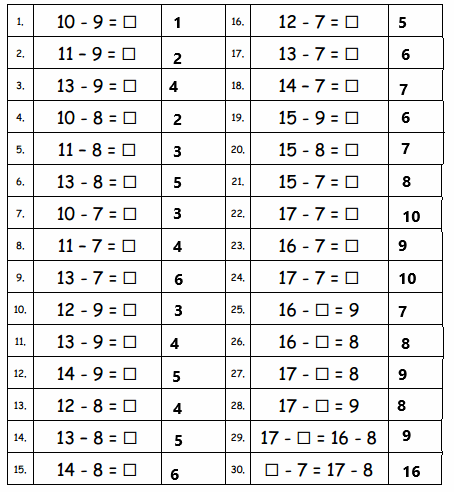
Question 1.
10 – 9 = ☐
Answer:
10 – 9 = 1
Explanation:
Subtraction is an arithmetic operation that represents the operation of removing objects from a collection. The result of a subtraction is called a difference. Subtract nine from ten then we got one.
Question 2.
11 – 9 = ☐
Answer:
11 – 9 = 2
Explanation:
Subtraction is an arithmetic operation that represents the operation of removing objects from a collection. The result of a subtraction is called a difference. Subtract nine from eleven then we got two.
Question 3.
13 – 9 = ☐
Answer:
13 – 9 = 4
Explanation:
Subtraction is an arithmetic operation that represents the operation of removing objects from a collection. The result of a subtraction is called a difference. Subtract nine from thirteen then we got four.
Question 4.
10 – 8 = ☐
Answer:
Subtraction is an arithmetic operation that represents the operation of removing objects from a collection. The result of a subtraction is called a difference. Subtract eight from ten then we got two.
Question 5.
11 – 8 = ☐
Answer:
11 – 8 = 3
Explanation:
Subtraction is an arithmetic operation that represents the operation of removing objects from a collection. The result of a subtraction is called a difference. Subtract eight from eleven then we got three.
Question 6.
13 – 8 = ☐
Answer:
13 – 8 = 5
Explanation:
Subtraction is an arithmetic operation that represents the operation of removing objects from a collection. The result of a subtraction is called a difference. Subtract eight from thirteen then we got five.
Question 7.
10 – 7 = ☐
Answer:
10 – 7 = 3
Explanation:
Subtraction is an arithmetic operation that represents the operation of removing objects from a collection. The result of a subtraction is called a difference. Subtract seven from ten then we got three.
Question 8.
11 – 7 = ☐
Answer:
11 – 7 = 4
Explanation:
Subtraction is an arithmetic operation that represents the operation of removing objects from a collection. The result of a subtraction is called a difference. Subtract seven from eleven then we got four.
Question 9.
13 – 7 = ☐
Answer:
13 – 7 = 6
Explanation:
Subtraction is an arithmetic operation that represents the operation of removing objects from a collection. The result of a subtraction is called a difference. Subtract seven from thirteen then we got six.
Question 10.
12 – 9 = ☐
Answer:
12 – 9 = 3
Explanation:
Subtraction is an arithmetic operation that represents the operation of removing objects from a collection. The result of a subtraction is called a difference. Subtract nine from twelve then we got three.
Question 11.
13 – 9 = ☐
Answer:
13 – 9 = 4
Explanation:
Subtraction is an arithmetic operation that represents the operation of removing objects from a collection. The result of a subtraction is called a difference. Subtract nine from thirteen then we got four.
Question 12.
14 – 9 = ☐
Answer:
14 – 9 = 5
Explanation:
Subtraction is an arithmetic operation that represents the operation of removing objects from a collection. The result of a subtraction is called a difference. Subtract nine from fourteen then we got five.
Question 13.
12 – 8 = ☐
Answer:
12 – 8 = 4
Explanation:
Subtraction is an arithmetic operation that represents the operation of removing objects from a collection. The result of a subtraction is called a difference. Subtract eight from twelve then we got four.
Question 14.
13 – 8 = ☐
Answer:
13 – 8 = 5
Explanation:
Subtraction is an arithmetic operation that represents the operation of removing objects from a collection. The result of a subtraction is called a difference. Subtract eight from thirteen then we got five.
Question 15.
14 – 8 = ☐
Answer:
14 – 8 = 6
Explanation:
Subtraction is an arithmetic operation that represents the operation of removing objects from a collection. The result of a subtraction is called a difference. Subtract eight from fourteen then we got six.
Question 16.
12 – 7 = ☐
Answer:
12 – 7 = 5
Explanation:
Subtraction is an arithmetic operation that represents the operation of removing objects from a collection. The result of a subtraction is called a difference. Subtract seven from twelve then we got five.
Question 17.
13 – 7 = ☐
Answer:
13 – 7 = 6
Explanation:
Subtraction is an arithmetic operation that represents the operation of removing objects from a collection. The result of a subtraction is called a difference. Subtract seven from thirteen then we got six.
Question 18.
14 – 7 = ☐
Answer:
14 – 7 = 7
Explanation:
Subtraction is an arithmetic operation that represents the operation of removing objects from a collection. The result of a subtraction is called a difference. Subtract seven from fourteen then we got seven.
Question 19.
15 – 9 = ☐
Answer:
15 – 9 = 6
Explanation:
Subtraction is an arithmetic operation that represents the operation of removing objects from a collection. The result of a subtraction is called a difference. Subtract nine from fifteen then we got six.
Question 20.
15 – 8 = ☐
Answer:
15 – 8 = 7
Explanation:
Subtraction is an arithmetic operation that represents the operation of removing objects from a collection. The result of a subtraction is called a difference. Subtract eight from fifteen then we got seven.
Question 21.
15 – 7 = ☐
Answer:
15 – 7 = 8
Explanation:
Subtraction is an arithmetic operation that represents the operation of removing objects from a collection. The result of a subtraction is called a difference. Subtract seven from fifteen then we got eight.
Question 22.
17 – 7 = ☐
Answer:
17 – 7 = 10
Explanation:
Subtraction is an arithmetic operation that represents the operation of removing objects from a collection. The result of a subtraction is called a difference. Subtract seven from seventeen then we got ten.
Question 23.
16 – 7 = ☐
Answer:
16 – 7 = 9
Explanation:
Subtraction is an arithmetic operation that represents the operation of removing objects from a collection. The result of a subtraction is called a difference. Subtract seven from sixteen then we got nine.
Question 24.
17 – 7 = ☐
Answer:
17 – 7 = 10
Explanation:
Subtraction is an arithmetic operation that represents the operation of removing objects from a collection. The result of a subtraction is called a difference. Subtract seven from seventeen then we got ten.
Question 25.
16 – ☐ = 9
Answer:
16 – 7 = 9
Explanation:
Subtraction is an arithmetic operation that represents the operation of removing objects from a collection. The result of a subtraction is called a difference. Subtract seven from sixteen then we got nine.
Question 26.
16 – ☐ = 8
Answer:
16 – 8 = 8
Explanation:
Subtraction is an arithmetic operation that represents the operation of removing objects from a collection. The result of a subtraction is called a difference. Subtract sixteen from eight then we got eight.
Question 27.
17 – ☐ = 8
Answer:
17 – 9 = 8
Explanation:
Subtraction is an arithmetic operation that represents the operation of removing objects from a collection. The result of a subtraction is called a difference. Subtract nine from seventeen then we got eight.
Question 28.
17 – ☐ = 9
Answer:
17 – 8 = 9
Explanation:
Subtraction is an arithmetic operation that represents the operation of removing objects from a collection. The result of a subtraction is called a difference. Subtract eight from seventeen then we got nine.
Question 29.
17 – ☐ = 16 – 8
Answer:
17 – 9 = 16 – 8
Explanation:
Subtraction is an arithmetic operation that represents the operation of removing objects from a collection. The result of a subtraction is called a difference. Subtract nine from seventeen then we got eight. Subtract eight from sixteen then we got eight. Both are equal expressions.
Question 30.
☐ – 7 = 17 – 8
Answer:
16 – 7 = 17 – 8
Explanation:
Subtraction is an arithmetic operation that represents the operation of removing objects from a collection. The result of a subtraction is called a difference. Subtract seven from sixteen then we got nine. Subtract eight from seventeen then we got nine. Both are equal expressions.
B
*Write the missing number.
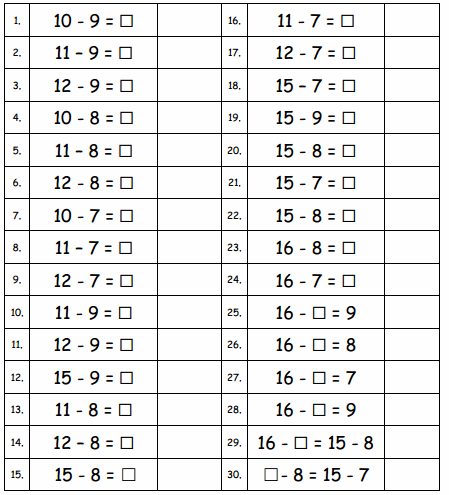
Answer:

Question 1.
10 – 9 = ☐
Answer:
10 – 9 = 1
Explanation:
Subtraction is an arithmetic operation that represents the operation of removing objects from a collection. The result of a subtraction is called a difference. Subtract nine from ten then we got one.
Question 2.
11 – 9 = ☐
Answer:
11 – 9 = 2
Explanation:
Subtraction is an arithmetic operation that represents the operation of removing objects from a collection. The result of a subtraction is called a difference. Subtract nine from eleven then we got two.
Question 3.
12 – 9 = ☐
Answer:
12 – 9 = 3
Explanation:
Subtraction is an arithmetic operation that represents the operation of removing objects from a collection. The result of a subtraction is called a difference. Subtract nine from twelve then we got three.
Question 4.
10 – 8 = ☐
Answer:
10 – 8 = 2
Explanation:
Subtraction is an arithmetic operation that represents the operation of removing objects from a collection. The result of a subtraction is called a difference. Subtract eight from ten then we got two.
Question 5.
11 – 8 = ☐
Answer:
11 – 8 = 3
Explanation:
Subtraction is an arithmetic operation that represents the operation of removing objects from a collection. The result of a subtraction is called a difference. Subtract eight from ten then we got three.
Question 6.
12 – 8 = ☐
Answer:
12 – 8 = 4
Explanation:
Subtraction is an arithmetic operation that represents the operation of removing objects from a collection. The result of a subtraction is called a difference. Subtract eight from ten twelve we got four.
Question 7.
10 – 7 = ☐
Answer:
10 – 7 = 3
Explanation:
Subtraction is an arithmetic operation that represents the operation of removing objects from a collection. The result of a subtraction is called a difference. Subtract seven from ten then we got three.
Question 8.
11 – 7 = ☐
Answer:
11 – 7 = 4
Explanation:
Subtraction is an arithmetic operation that represents the operation of removing objects from a collection. The result of a subtraction is called a difference. Subtract seven from eleven then we got four.
Question 9.
12 – 7 = ☐
Answer:
12 – 7 = 5
Explanation:
Subtraction is an arithmetic operation that represents the operation of removing objects from a collection. The result of a subtraction is called a difference. Subtract seven from twelve then we got five.
Question 10.
11 – 9 = ☐
Answer:
11 – 9 = 2
Explanation:
Subtraction is an arithmetic operation that represents the operation of removing objects from a collection. The result of a subtraction is called a difference. Subtract nine from eleven then we got two.
Question 11.
12 – 9 = ☐
Answer:
12 – 9 = 3
Explanation:
Subtraction is an arithmetic operation that represents the operation of removing objects from a collection. The result of a subtraction is called a difference. Subtract nine from twelve then we got three.
Question 12.
15 – 9 = ☐
Answer:
15 – 9 = 6
Explanation:
Subtraction is an arithmetic operation that represents the operation of removing objects from a collection. The result of a subtraction is called a difference. Subtract nine from fifteen then we got six.
Question 13.
11 – 8 = ☐
Answer:
11 – 8 = 3
Explanation:
Subtraction is an arithmetic operation that represents the operation of removing objects from a collection. The result of a subtraction is called a difference. Subtract eight from eleven then we got three.
Question 14.
12 – 8 = ☐
Answer:
12 – 8 = 4
Explanation:
Subtraction is an arithmetic operation that represents the operation of removing objects from a collection. The result of a subtraction is called a difference. Subtract eight from twelve then we got four.
Question 15.
15 – 8 = ☐
Answer:
15 – 8 = 7
Explanation:
Subtraction is an arithmetic operation that represents the operation of removing objects from a collection. The result of a subtraction is called a difference. Subtract eight from fifteen then we got seven.
Question 16.
11 – 7 = ☐
Answer:
11 – 7 = 4
Explanation:
Subtraction is an arithmetic operation that represents the operation of removing objects from a collection. The result of a subtraction is called a difference. Subtract seven from eleven then we got four.
Question 17.
12 – 7 = ☐
Answer:
12 – 7 = 5
Explanation;
Subtraction is an arithmetic operation that represents the operation of removing objects from a collection. The result of a subtraction is called a difference. Subtract seven from twelve then we got five.
Question 18.
15 – 7 = ☐
Answer:
15 – 7 = 8
Explanation:
Subtraction is an arithmetic operation that represents the operation of removing objects from a collection. The result of a subtraction is called a difference. Subtract seven from fifteen then we got eight.
Question 19.
15 – 9 = ☐
Answer:
15 – 9 = 6
Explanation:
Subtraction is an arithmetic operation that represents the operation of removing objects from a collection. The result of a subtraction is called a difference. Subtract nine from fifteen then we got six.
Question 20.
15 – 8 = ☐
Answer:
15 – 8 = 7
Explanation:
Subtraction is an arithmetic operation that represents the operation of removing objects from a collection. The result of a subtraction is called a difference. Subtract eight from fifteen then we got seven.
Question 21.
15 – 7 = ☐
Answer:
15 – 7 = 8
Explanation:
Subtraction is an arithmetic operation that represents the operation of removing objects from a collection. The result of a subtraction is called a difference. Subtract seven from fifteen then we got eight.
Question 22.
15 – 8 = ☐
Answer:
15 – 8 = 7
Explanation:
Subtraction is an arithmetic operation that represents the operation of removing objects from a collection. The result of a subtraction is called a difference. Subtract eight from fifteen then we got seven.
Question 23.
16 – 8 = ☐
Answer:
16 – 8 = 8
Explanation:
Subtraction is an arithmetic operation that represents the operation of removing objects from a collection. The result of a subtraction is called a difference. Subtract eight from sixteen then we got eight.
Question 24.
16 – 7 = ☐
Answer:
16 – 7 = 9
Explanation:
Subtraction is an arithmetic operation that represents the operation of removing objects from a collection. The result of a subtraction is called a difference. Subtract seven from sixteen then we got nine.
Question 25.
16 – ☐ = 9
Answer:
16 – 7 = 9
Explanation:
Subtraction is an arithmetic operation that represents the operation of removing objects from a collection. The result of a subtraction is called a difference. Subtract seven from sixteen then we got nine.
Question 26.
16 – ☐ = 8
Answer:
16 – 8 = 8
Explanation:
Subtraction is an arithmetic operation that represents the operation of removing objects from a collection. The result of a subtraction is called a difference. Subtract eight from sixteen then we got eight.
Question 27.
16 – ☐ = 7
Answer:
16 – 9 = 7
Explanation:
Subtraction is an arithmetic operation that represents the operation of removing objects from a collection. The result of a subtraction is called a difference. Subtract nine from sixteen then we got seven.
Question 28.
16 – ☐ = 9
Answer:
16 – 7 = 9
Explanation:
Subtraction is an arithmetic operation that represents the operation of removing objects from a collection. The result of a subtraction is called a difference. Subtract seven from sixteen then we got nine.
Question 29.
16 – ☐ = 15 – 8
Answer:
16 – 9 = 15 – 8
Explanation:
Subtraction is an arithmetic operation that represents the operation of removing objects from a collection. The result of a subtraction is called a difference. Subtract nine from sixteen then we got seven. Subtract eight from fifteen then we got seven. Both are equal expression.
Question 30.
☐ – 8 = 15 – 7
Answer:
16 – 8 = 15 – 7
Explanation:
Subtraction is an arithmetic operation that represents the operation of removing objects from a collection. The result of a subtraction is called a difference. Subtract eight from sixteen then we got eight. Subtract seven from fifteen then we got eight. Both are equal expression.
Eureka Math Grade 1 Module 2 Lesson 21 Problem Set Answer Key
There were 16 dogs playing at the park. Seven of the dogs went home. How many of the dogs are still at the park?
Question 1.
Circle all the student work that correctly matches the story.
a. 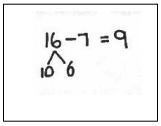
Answer:
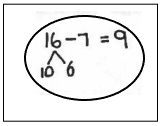
Nine dogs are still at the park.
Explanation:
There were 16 dogs playing at the park. Seven of the dogs went home. In the above image we can observe a number sentence 16 – 7 = 9. Break sixteen into ten and six. Take seven from the ten. It’s called the take from ten strategy. Then three and six make nine. Nine dogs are still at the park. Draw a circle for the student work because it correctly matches to the story.
b. 
Answer:
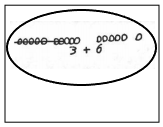
Nine dogs are still at the park.
Explanation:
There were 16 dogs playing at the park. Seven of the dogs went home. In the above image we can observe a number sentence 16 – 7 = 9. Break sixteen into ten and six. Take seven from the ten. It’s called the take from ten strategy. Cross out seven circles Then three and six make nine. Nine dogs are still at the park. Draw a circle for the student work because it correctly matches to the story.
c. 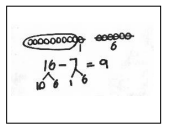
Answer:
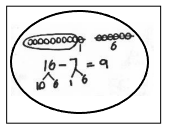
Explanation:
A number bond is a simple addition of two numbers that add up to give the sum. There were 16 dogs playing at the park. Seven of the dogs went home. In the above image we can observe a number sentence 16 – 7 = 9. Break sixteen into ten and six. Break seven in to one and six. Cross out seven circles. Then we have nine. Nine dogs are still at the park. Draw a circle for the student work because it correctly matches to the story.
d. 
Answer:
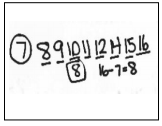
Explanation:
There were 16 dogs playing at the park. Seven of the dogs went home. In the above image we can observe numbers from seven in that thirteen number is missing. we can observe 16 – 7 = 8 number sentence the result is not correct.
e. 
Answer:
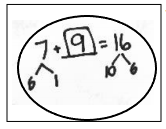
Explanation:
A number bond is a simple addition of two numbers that add up to give the sum. There were 16 dogs playing at the park. Seven of the dogs went home. In the above image we can observe a number sentence 7 + 9 = 16. Break sixteen into ten and six. Break seven in to one and six. ADD seven with nine then we got sixteen. Nine dogs are still at the park. Draw a circle for the student work because it correctly matches to the story.
f. 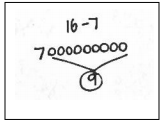
Answer:
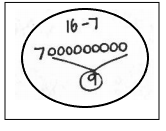
Explanation:
There were 16 dogs playing at the park. Seven of the dogs went home. In the above image we can observe a number sentence 16 – 7 . Subtract seven from sixteen then we got nine. Nine dogs are still at the park. Draw a circle for the student work because it correctly matches to the story.
Question 2.
Fix the work that was incorrect by making a new drawing in the space below with the matching number sentence.
Answer:
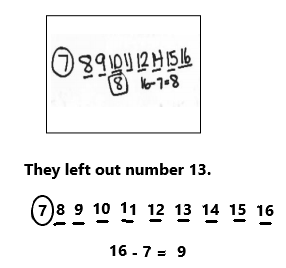
Explanation:
In the above image we can observe numbers from seven to sixteen. But they left the thirteen number in that image. ADD thirteen to that number series. Subtract seven from sixteen then we got nine.
Solve on your own. Show your thinking by drawing or writing. Write a statement to answer the question.
Question 3.
There were 12 sugar cookies in the box. My friend and I ate 5 of them. How many cookies are left in the box?
Answer:
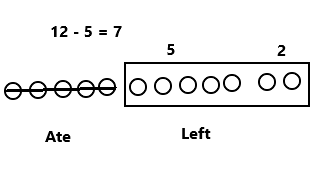
There are 7 cookies left in the box.
Explanation:
There were 12 sugar cookies in the box. My friend and I ate 5 of them. In the above image we can observe a number sentence 12- 5 = 7. Break twelve into ten and two. Cross out five circles. Then we have seven cookies. There are 7 cookies left in the box.
Question 4.
Megan checked out 17 books from the library. She read 9 of them. How many does she have left to read?
Answer:
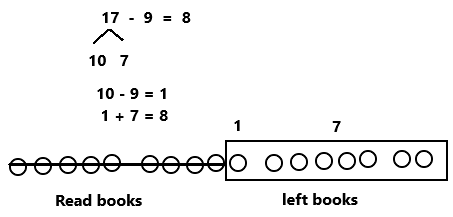
Explanation:
Megan checked out 17 books from the library. She read 9 of them. A number bond is a simple addition of two numbers that add up to give the sum. In the above image we can observe a number sentence 17 – 9 = 8. Break seventeen into ten and seven. Subtract nine books from ten books. Then we have one book. Cross out nine circles. ADD one book with seven books results eight books. She have eight books left to read.
When you are done, share your solutions with a partner. How did your partner solve each problem? Be ready to share how your partner solved the problem.
Eureka Math Grade 1 Module 2 Lesson 21 Exit Ticket Answer Key
Meg thinks using the take from ten strategy is the best way to solve the following word problem. Bill thinks that solving the problem using the count on strategy is a better way. Solve both ways, and explain which strategy you think is best.
Mike and Sally have 6 cats. They have 14 pets in all. How many pets do they have that are not cats?

I think ___ strategy is best because ____
________________________
_________________________
Answer:
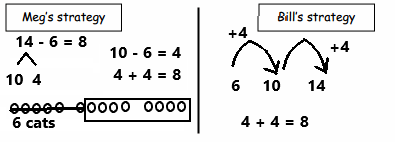
I think Meg’s strategy is best because he drew the total 14 into 5-group rows then he crossed out six. There are four and four make eight. They are 8 pets that are not cats.
Explanation:
Mike and Sally have 6 cats. They have 14 pets in all. A number bond is a simple addition of two numbers that add up to give the sum. In the above image we can observe a Meg’s strategy with a number sentence 14 – 6 = 8. Break fourteen into ten and four. Subtract six cats from ten cats. Then we have four cats. Cross out six circles. ADD four cats with four cats results eight cats. They are 8 pets that are not cats.
In the above image we can observe Bill’s strategy. Difference from six to ten is four and ten to fourteen is four. count the numbers from six to fourteen which results eight. 8 pets that are not cats.
Eureka Math Grade 1 Module 2 Lesson 21 Homework Answer Key
Olivia and Jake both solved the word problems. Write the strategy used under their work. Check their work. If incorrect, solve correctly.
If solved correctly, solve using a different strategy.
Question 1.
A fruit bowl had 13 apples. Mike ate 6 apples from the fruit bowl. How many apples were left?

a. Strategy: __________
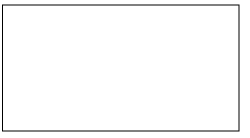
Answer:
Olivia’s work
Take from ten strategy

7 apples were left in the fruit bowl.
Explanation:
A fruit bowl had 13 apples. Mike ate 6 apples from the fruit bowl. A number bond is a simple addition of two numbers that add up to give the sum. In the above image we can observe a number sentence 13 – 6 = 7. Break thirteen into ten and three. Subtract six apples from ten apples. It is take from ten strategy. Then we have four apples. Cross out six apples. ADD four apples with three apples results seven apples. 7 apples were left in the fruit bowl.
b. Strategy: __________

Answer:
Jake’s work
The count on strategy
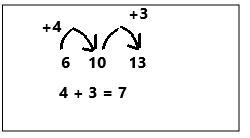
Explanation:
A fruit bowl had 13 apples. Mike ate 6 apples from the fruit bowl. In the above image we can observe Jakes work. Difference from six to ten is four and ten to thirteen is three. count the numbers from six to thirteen which results seven. Seven apples are left in the fruit bowl.
c. Explain your strategy choice below.
Explanation:
I thought take from ten strategy is the best way to solve the number sentence 13 – 6 = 7 compared to count on strategy.
A fruit bowl had 13 apples. Mike ate 6 apples from the fruit bowl. A number bond is a simple addition of two numbers that add up to give the sum. In the above image we can observe a number sentence 13 – 6 = 7. Break thirteen into ten and three. Subtract six apples from ten apples. It is take from ten strategy. Then we have four apples. Cross out six apples. ADD four apples with three apples results seven apples. 7 apples were left in the fruit bowl.
Question 2.
Drew has 17 baseball cards in a box. He has 8 cards with Red Sox players, and the rest are Yankees players. How many Yankees player cards does Drew have in his box?
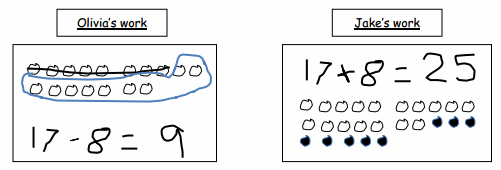
a. Strategy: _____________________

Answer:
Olivia’s work
Take from ten strategy

Drew have 9 Yankees player cards in his box.
Explanation:
Drew has 17 baseball cards in a box. He has 8 cards with Red Sox players, and the rest are Yankees players. A number bond is a simple addition of two numbers that add up to give the sum. In the above image we can observe a number sentence 17 – 8 = 9. Break seventeen into ten and seven. Subtract eight from ten. It is take from ten strategy. Then we have two. Cross out eight circles. ADD two with seven results nine. Drew have 9 Yankees player cards in his box
b. Strategy: ____________________

Answer:
Jake’s work
Count on strategy
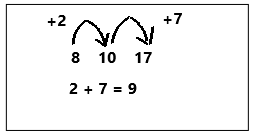
Explanation:
Drew has 17 baseball cards in a box. He has 8 cards with Red Sox players, and the rest are Yankees players. In the above image we can observe Jakes work. Difference from eight to ten is two and ten to seventeen is seven. count the numbers from eight to seventeen which results nine. Drew have 9 Yankees player cards in his box
c. Explain your strategy choice below.
Explanation:
I thought take from ten strategy is the best way to solve the number sentence 13 – 6 = 7 compared to count on strategy.
Drew has 17 baseball cards in a box. He has 8 cards with Red Sox players, and the rest are Yankees players. A number bond is a simple addition of two numbers that add up to give the sum. In the above image we can observe a number sentence 17 – 8 = 9. Break seventeen into ten and seven. Subtract eight from ten. It is take from ten strategy. Then we have two. Cross out eight circles. ADD two with seven results nine. Drew have 9 Yankees player cards in his box